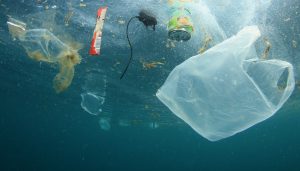Why is there still so much hidden plastic in our clothes?
It may be Plastic-Free July—but more than 60 per cent of our clothing is still made from the problem material. So, what’s the solution?
While many of us are trying to stop using plastic as much as possible, there’s one area of our lives that still contains a huge amount of the problem material: our clothing. In fact, synthetic fibres such as polyester make up more than 60 per cent of fibres produced globally. And although some brands are starting to move towards alternatives, a recent study found that 50 per cent of fast fashionis currently made from virgin plastic—meaning the industry is still responsible for vast volumes of brand-new plastic entering the world.
It’s important to remember that plastic comes from fossil fuels, which are the primary drivers of climate change. “Synthetic fabrics are a big part of the business model of oil and gas companies,” Josie Warden, co-author of the paper Fast Fashion’s Plastic Problem and head of regenerative design at London’s Royal Society for Arts (RSA), tells Vogue.
With a separate, new report in June estimating that synthetic materials are set to make up nearly 75 per cent of all textiles by 2030, it’s clear we’re still heading in the wrong direction. “[These materials] are seen as a growing field of output for oil and gas companies, which ultimately is problematic because we know that we need to be winding down the extraction of fossil fuels,” Warden adds.
Not only this, but synthetic fabrics release millions of microplastics into our oceans and waterways when we wash them, presenting a serious threat to marine life. Given that synthetics are not biodegradable, they can stay around for up to 200 years, all the time releasing more harmful microfibres and potentially toxic chemicals into the environment. With a shocking 92m tons of textile waste being produced every year, according to a 2017 Global Fashion Agenda reportending up in landfill or being incinerated, the urgency of the situation can’t be underestimated.
“[Plastic] is everywhere and we have to do something about it,” says Liesl Truscott, European and materials strategy director of the nonprofit Textile Exchange. “We’ve got to wake up to the [issues of] waste and microplastics, the impact on nature, biodiversity, and our food chain. It’s a problem and it’s not going away fast.”
Fashion’s reliance on synthetics
Fashion’s reliance on synthetics dates back to the 1940s and 1950s when nylon and polyester first emerged on the market as a rival to cotton, wool and silk. Fast forward to today, and these fibres are more readily available than ever before. “They’re resilient fibres, relatively inexpensive and reliable,” Truscott explains. “Whereas cotton and other natural fibres may be a little bit more vulnerable to availability or weather conditions and climate change.”
Often, polyester is blended with cotton and other natural fibres to improve its strength and durability, but this causes an added problem when it comes to the end of its life. “It’s probably one of the worst options because you’ve blended a natural material with a synthetic,” Truscott says. “In terms of being able to recycle it and pull those materials apart for different recycling streams, it’s pretty impossible at the moment.”
The demands we place on our clothing nowadays also means plastic is difficult to eliminate from our wardrobes altogether. “We like our technical clothing, a little ironically, for getting out into nature,” Truscott says. “Synthetic fibres [are used] for its lightweight, high-strength attributes and being able to wick away moisture.” Activewear and underwear are also areas where it’s difficult to move away from plastic altogether because of the need for that all-important stretch.
What’s the solution?
Given the amount of plastic that already exists on our planet, recycled polyester—which is often made from plastic bottles or discarded fishing nets—is currently a better option than virgin plastic, but shouldn’t be seen as a long-term solution. “Recycled plastic in clothing will still end up being incinerated or put into landfill at the end of that second life, so it’s quite a short loop,” Warden explains.
At the moment, it’s still extremely difficult to recycle textiles into new clothes—with less than one per cent currently being recycled in this way. “There is very little infrastructure for the recycling of synthetic fibres,” Warden continues. Mechanical recycling, where textiles are shredded, usually reduces the quality of the fibre, while chemical recycling, which involves breaking down materials into chemical form, is energy-intensive and can also lead to toxic substances being released.



